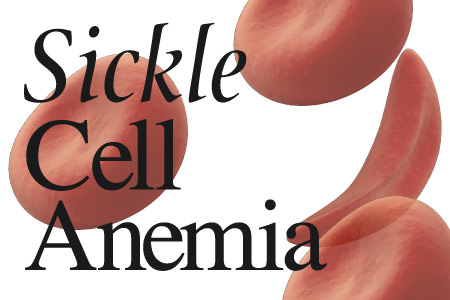
Sickle Cell Anemia
Issue 70 July 2010
Dr Noreen A. Kassam discusses the inherited disease which is more likely to affect ethnic minorities.
Sickle cell anemia is a serious disorder that can cause chronic pain and ill health as well as an early death. This inherited disease causes the body to produce red blood cells that are shaped liked sickles or crescents instead of round. Normal red blood cells (erythrocytes) are disc shaped, which makes it easy for them to flow past each other and other cells and through every blood vessel in the body. Sickle-shaped red blood cells cannot move through the body easily and often form stiff clumps that can get stuck in the blood vessels. Think of boomerangs that are tangled together and don’t move easily, while footballs bounce off each other and keep rolling.
In sickle cell anemia, the red blood cell clumps can prevent or reduce blood flow to the limbs and organs of the body. This can cause pain, organ damage, weakened muscles, fatigue, infections, slow healing and even strokes.
There is no cure for sickle cell anemia, but consistent treatment and maintaining overall health can keep many people with sickle cell anemia in reasonably good health. In the pat 30 years, life expectancy for sickle cell anemia patients has improved and many now live beyond their 40s and 50s.
What is Anemia?
Anemia is a disorder in which your blood has less than normal amounts of healthy red blood cells. In the most common kind, dietary anemia, this may be due to not enough iron and other nutrients that are needed to make red blood cells. Normal healthy red blood cells are made in the bone marrow and live for about 120 days, before being replaced. In sickle cell anemia, there are lower than normal amounts of red blood cells because sickle cells are more fragile and last only about 10 to 20 days. The bone marrow cannot make new red blood cells fast enough, leading to low levels of red blood cells and decreased oxygen delivered to the body.
Causes
Sickle cell anemia is caused by deformed red blood cells that are unable to carry oxygen and nutrients to the cells of the body efficiently. This makes tissues unhealthy, prone to infections and unable to develop, renew or heal themselves properly. Sickle cells also form clumps and cause narrowing of blood vessels, and have a much shorter lifespan than healthy red blood cells. Red blood cells contain the vital protein haemoglobin, which is rich in iron and needed to carry oxygen from the lungs to the entire body.
In sickle cell anemia, a mutated gene causes haemoglobin to be defective and causes abnormal development in red blood cells. Sickle cells are stiffer and unable to squeeze through smaller blood vessels. They also stick together and form blood clots and clumps.
Sickle cell anemia is an inherited, lifelong disease that does not have a cure. People who have this disease inherit a gene called ‘haemoglobin S’ from both their parents.
Who is at Risk?
Sickle cell anemia affects millions of people around the world and is more common in some ethnic groups. This disorder is common in people of sub-Saharan African descent in the U.S, Canada and the U.K. It is also found in people from Saudi Arabia, India, Pakistan, Bangladesh, Mediterranean areas (Turkey, Italy and Greece) and Latin regions (Spain, Portugal, South America, Central America and Cuba).
Treatment
Sickle cell anemia has no cure, however there are a number of treatments to reduce symptoms and complications of this disease. In rare cases, bone marrow transplants have stopped symptoms completely, but this procedure for sickle cell anemia is still experimental. Other current treatments are under research and constantly improving. Most individuals require a combination of treatments such as pain medications, an oxygen mask, iron and folic acid supplements and medications to treat infections. Blood transfusions are also often needed to prevent or treat complications of sickle cell anemia such as an enlarged spleen, low red blood cells and low iron. Regular transfusion therapy can also prevent strokes and nervous complications, particularly in children who are at high risk. Vaccines and antibiotics may also be given to prevent lung and body infections. Ongoing researchers on gene therapy are focusing on whether it may be possible to ‘turn off’ the action of the gene haemoglobin S that causes sickle cell anemia.
Sickle Cell Anemia Symptoms
Blocked blood vessels or clumps of red blood cells in the vessels
Decrease in the number of red blood cells
Pain in the organs and joints
Pain and swelling in the hands and feet
Damage to the spleen
Frequent bacterial infections
Chest pain
Lung infections such as pneumonia
Skin ulcers on the lower legs
Damage to the retina causing vision problems
Delayed growth and development
Yellowing of the skin and eyes due to fast breakdown of red blood cells
Confusion or difficulty understanding and slurred, garbled or incoherent speech
Case Study - Zaynab Williamson
I am 30 years old and of African American descent. I know that several of my ancestors on my mother’s side had sickle cell anemia and both my parents carried the sickle cell trait, though they did not know it.
In my teens and early 20s some months were really tough, but I learned to recognise my specific triggers (all ‘sicklers’ have their own triggers that may cause symptoms). Mine are stress, colds, lack of sleep, wet climates and exposure to infections. Now the severity and frequency of my symptoms have decreased a lot. I also find that eating a balanced diet, lots of daily fluids, rest and vitamins help to keep symtoms such as fatigue and soreness away. I also take a garlic supplement which helps me because it improves blood flow.
I now volunteer to speak to and spend time with other sicklers, especially young children as I think it is very encouraging for them to see that I live a full, normal life.
In Islam, life trumps all, yet Muslims are ignoring a simple and effective life-saving initiative. Read why you should donate blood here.
Bookmark this |
|
Add to DIGG |
|
Add to del.icio.us |
|
Stumble this |
|
Share on Facebook |
|
Share this |
|
Send to a Friend |
|
Link to this |
|
Printer Friendly |
|
Print in plain text |
|


Comments
1 Comment
1
healthforever
19 Apr 11, 15:32
This article has complete information on Sickle cell
anemia, its causes and symptoms which has helped me
to know better about this disorder and the possible
treatments to reduce the symptoms. I've also found
Jobelyn Antioxidant product very helpful for my cure of
Sickle cell anemia.